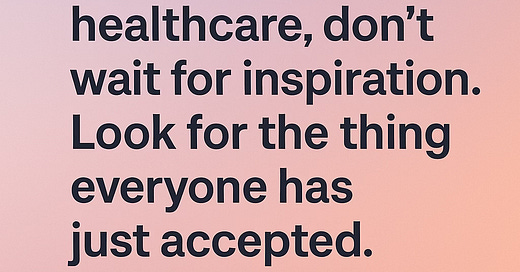Stop Waiting for a Healthcare Lightbulb Moment
Why we need more NerdMDs, and fewer visionary moonshots
When people talk about "redesigning healthcare," they often chase the next big idea. A moonshot. A grand epiphany. But in my experience, what actually moves the needle isn't brilliance. It's rethinking the painfully obvious.
Let me explain.
Most of our clinical workflows, especially in digital systems, are relics. They're designed for operational efficiency, yes, but usually not for the right people. We optimize for internal processes, not for patients. Or even for clinicians.
That optimization should be in that order: patients first. Clinicians a very close second.
A tiny but telling example: ordering medications in a typical EHR.
You type in the med. Finalize the sig. Set the quantity. Sign the order. Only then does the system yell at you: "Hey, you forgot to choose a pharmacy!" So you dig back in. Find the pharmacy. Re-sign. All of it friction. All of it dumb.
Now contrast that with how it should be. Just order the medication. The patient gets a secure link. No app required. They click in, see their meds, and pick a pharmacy using a geo-based search tool. Done.
You don’t need a flashy app. I don't need to know the CVS they want their lisinopril sent to. Patients are trained to instinctively offer this info, like it's still 2005. It's insane.
No AI. Or blockchain. Or some flashy interface. Just a clean rethink of a broken step. Removed the hidden burdens on clinicians. And make it easier for patients, too.
Another example? Signing up for a healthcare portal.
Typical portal signup (aka MyChart):
Activation Code Needed – You typically get this during a clinic visit or via email (or sometimes snail mail)
Detailed Verification – You enter personal info and sometimes undergo third-party ID verification.
Account Setup – Create a username, password, and set up two-factor authentication.
Mobile App Optional – You can download their app for "easier" access.
The Way it Should be:
Enter your phone. Receive SMS code.
Account created. (Signup is done at this point.)
Enter name and DOB
Confirm insurance policy
Done
What looks like more steps actually takes about 30 seconds. Because it's built around the user, not the bureaucracy.
This is the kind of redesign healthcare actually needs.
Not more ideas. Better judgment.
Redesign isn't about invention. It's about excavation. Finding the spots where we’ve inherited legacy choices and quietly, persistently, making better ones.
“Redesign isn't about invention. It's about excavation.”
Most health systems are full of status quo sediment: technical debt, policy inertia, outdated workflows that no one questions because they "work." Until you realize they don’t.
We don’t need visionaries. (Ok we do need some.) But we need editors. And really good ones. I'm so thankful I found my tribe.
If you want to fix healthcare, don’t wait for inspiration. Look for the thing everyone has just accepted. The screen people click past. The extra field no one questions. The needless ping-pong between systems. And ask: why? This is what I have instinctively done my entire career: Ask questions.
It won’t always be sexy. But it’ll be real.
The truth is, patients feel this friction. So do physicians. We just don’t always name it. But when you fix it, it’s unmistakable. The silence after a smooth experience? That’s redesign done right.
So if you're in health tech or care delivery: skip the spotlight. Bring a shovel.
Dig up the status quo.
And start editing.
This is the invaluable expertise a skilled Applied Clinical Informatician brings to the table. Whether you're at a massive legacy health system or a nimble, agile startup, these are the people who know where to dig. You may not know what an "informatician" is... but I just described what they do above.
This is why we need way more NerdMDs, and NerdRNs, and NerdAPPs.






OMG you nailed it with the Rx writing. And I in administration get faxed back questions from a pharmacy (have you considered [ x ] medication instead? how about a 90-day Rx instead?) including Rx script questions for OTC meds. Each and every one of them makes me angry. this is administrative NONESENSE!
Remove friction between the patient and the answers. With 80% of the cost being chronic disease, many viable solutions to reduce chronic disease, and 80% of people not getting standard of care.....
It appears that the front end of the healthcare system is the best place to remove friction.
UI and programming people know this. I would guess they can't do it because of specific structural barriers. HIPAA, insurance, CMS, etc ---- unintentionally dropping friction into the system.
I do sense the advantage of firms like HIMS/HERS is that they are operating on certain disease classes that are OK with cash pay. And building a base of consumers who expect less friction. As a class of service providers HIMs, Function, and others have the opportunity to change these workflows. As they build goodwill, they will also change the power dynamic, where old-school HC now treats them as annoyances, but next-gen HC will treat them as power brokers, not unlike how Amazon went from an online bookstore to an information and logistics critical rail.